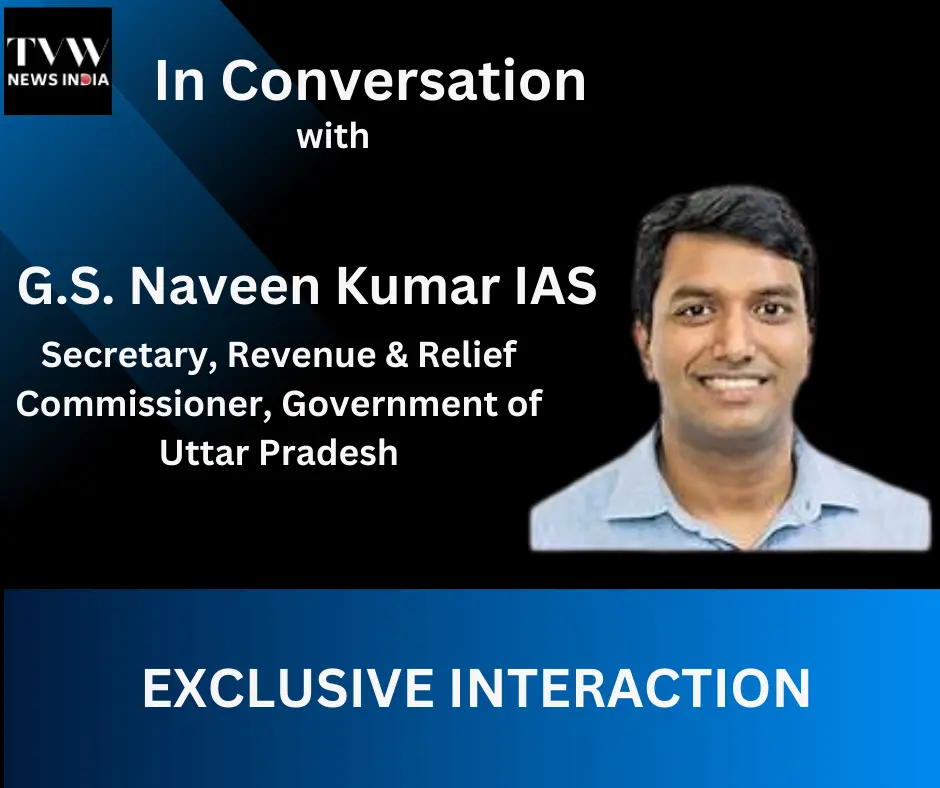In this exclusive interview with TVW News India, G.S. Naveen Kumar, IAS, the Revenue Secretary and Relief Commissioner of Uttar Pradesh, sheds light on the dual responsibilities he holds in revenue administration and disaster management. With over 15 years of experience in civil service, Mr. Kumar shares with Shiva Y how he ensures the smooth delivery of citizen-centric services, monitors timely dispute resolutions, and provides immediate relief during natural disasters. He also discusses innovative initiatives like the Climate Resilience Observatory (CRO) and the integration of emerging technologies in governance, reflecting his commitment to improving service delivery and enhancing governance in the state.
As the Revenue Secretary and Relief Commissioner of Uttar Pradesh, what are your primary responsibilities, and how do you balance the dual roles of revenue administration and disaster management?
In both roles, my primary responsibility is to ensure platforms & an optimal ecosystem for the delivery of citizen centric services in smooth & streamline manner within the SLAs defined under the Janhit Guarantee Act, Uttar Pradesh. As revenue secretary, I have also monitored the timely resolution of disputes being raised by citizens in various revenue courts. As a relief commissioner, my primary objective is to provide immediate relief to the victims impacted by any natural disaster in the State. Also, in the last few months, we have envisioned the concept of Climate Resilience Observatory (CRO) in the state where more emphasis has been given on the resilience of infrastructure than post relief measures. Presently, a dedicated CRO lab is also established on the IIIT, Lucknow campus where real time monitoring of data from various sources like IMD, IITM-Pune, IoT based sensors, AWS/ARG etc. is going-on & developing various Decision Support Systems (DSS) for the Government.
With over 15 years of civil service experience, can you share some key highlights and learnings from your diverse roles in Andhra Pradesh and Uttar Pradesh?
As you know, as a civil service administrator, my primary duty is to handle the organization in a manner that can enhance productivity by providing optimum Government Services to the citizens. Also, being a technocrat, I have always tried to incorporate emerging technologies into Government ecosystems. I have started my civil service journey in Uttar Pradesh & I got the position of Special Secretary, IT & Electronics Department at the initial stage. During this period, I put my 100% effort in automating the G2C services (200+), CSCs, e-Office implementation, e-Village conceptualization & its pilot, set-up of HCL IT City & IIIT, Lucknow etc. When I was in Andhra Pradesh, I held the position of Secretary, Medical & Health Department where I developed the concept of implementing Micro Services using Managed Service Provider (MSP) platform. This helped in providing the Citizen centric services (Ease of living) & promoting real time Governance in the State.
Managing disaster relief in India’s most populous state is a significant challenge, Can you discuss some of the most critical disaster management initiatives you have led and their impact on the community?
As Uttar Pradesh is highly disaster vulnerable state in the country, it is impacted by multiple hazards including floods, droughts, storms, fire, hailstorms, earthquake and lightning of high severity. We are developing a Climate Resilience Observatory (CRO) in the state having proactive approach to address the disaster and build a system of resilience to be proactive in reducing the loss of lives, livelihood and also the infrastructure. Presently, as you know multiple rivers originating from Nepal are creating devastating flood situations in few districts like Shrawasti, Bahraich, Balrampur, Kheri, Gonda, Sitapur, Barabanki, Shajahanpur. So, a team from NDRF, SDRF, PAC has been appointed in these areas & providing all necessary services to the victims. Even, they are evacuating the victims safely without causing a single injury in few incidents recently happened in the State. Also, various IOT based Sensor data (AWS/ARG) is helpful in getting insights, proper forecasting, Dissemination of Early Warning Systems (EWS) for efficient decision making.
You are passionate about improving the lives of citizens and ensuring effective governance. What innovative strategies have you implemented to enhance service delivery and governance in Uttar Pradesh?
I have already answered in your previous question that we are focusing more on real time governance through which more priority has been given on providing timely & hassle free services to the citizens. Initially, we have made more efforts on changing complex Government processes into simple processes using Business Process Re-engineering (BPR), Gap Analysis, As-Is/To-Be approach & involvement of latest technologies. More interactive Portals. Websites, ChatBots, Mobile Apps, Grievance Redressal Models have developed for the ease of citizens. The progress/compliance of the service delivery is continuously monitored using Hon’ble CM dashboard (DARPAN) where Key Performance Indicators (KPIs) are integrated using real time APIs.
How do you foster a culture of innovation, collaboration, and accountability within the public sector teams you lead?
As you know due to the proliferation of technology in the last few decades, I have always tried to follow a collaborative approach where all concerned stakeholders like Industry Partners, Academia, OEMs, System Integrators (SI) work closely for better design & development of any citizen centric schemes. Before floating any RFP, we always perform Proof of Concept (POCs) by publishing open Expression of Interest (EOI) to better understand the requirements, Scope of Work (SoW) & technologies too.
How is technology being leveraged in revenue administration and disaster management in Uttar Pradesh? Can you share any specific projects or initiatives where technology has played a pivotal role?
I already briefed you on your first question. The projects where emerging technologies have meaningful impacts are depicted below:-
- Climate Resilience Observatory (CRO) —- Developed on AI/ML based Use Cases
- e-Chakbandi —- Automation of CH Forms using DGPS/Rover based survey, robust Algorithms for Chak Allocation & it’s Carvation
- Fast Track Delivery of Revenue Certificates —- Developed on AADHAAR & Family ID platform
Looking ahead, what are your key priorities and vision for the future of revenue administration and disaster management in Uttar Pradesh?
I have already highlighted my priorities with regard to providing Citizen Centric Services in timely & hassle free manner. Few additional points are depicted below:-
- Development of Resilience for Critical Infrastructure
- Robust Forecasting models for Disaster Management
- Predictive & Prescriptive models
- Suo-motto delivery of Revenue Services
- Integrated models for Bhulekh Services
- Real time Governance for better administration
Note: We are also on WhatsApp, LinkedIn, and YouTube, to get the latest news updates, Join our Channels. WhatsApp– Click here, and for LinkedIn– Click Here













